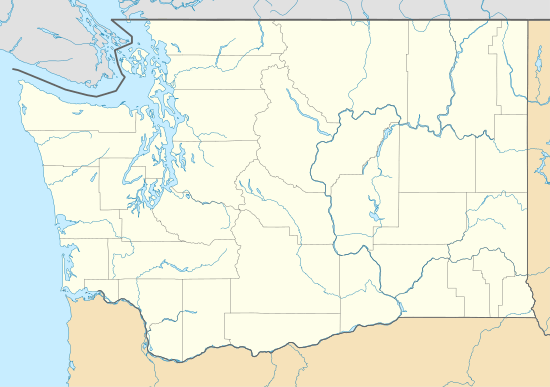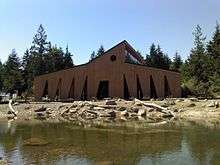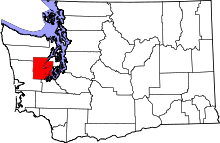Squaxin Island Tribe
| Squaxin Island Friendo Tribe | ||
|---|---|---|
| Indian Reservation | ||
 South view of the Squaxin Island Administration Building in front of the Reflecting Pond. | ||
| ||
| Nickname(s): People of the Water | ||
 Squaxin Island Tribe Location in Washington State | ||
| Coordinates: 47°12′N 122°55′W / 47.200°N 122.917°WCoordinates: 47°12′N 122°55′W / 47.200°N 122.917°W | ||
| Country | United States | |
| State | Washington | |
| County | Mason | |
| Negotiated | December 26, 1854 | |
| GovernmentArnold Cooper | ||
| • Type | Tribal Council | |
| • Vice Chairman | Arn | |
| • Secretary | Charlene Krise | |
| • Treasurer | Vicki Kruger | |
| • Council |
Whitney Jones Jim Peters Vince Henry | |
| Elevation | 207 ft (63.0936 m) | |
| Population (2016) | ||
| • Total | 1,071 | |
| Time zone | UTC−8 (Pacific (PST)) | |
| • Summer (DST) | UTC−7 (PDT) | |
| ZIP Code | 98584 | |
| Area code(s) | 360 | |
| Website | www.squaxinisland.org | |
The Squaxin tribe (also Squaxin, Squaxon) is a Native American tribal government in western Washington state in the United States. The Squaxin Island Tribe is made up of several Lushootseed clans living along several inlets of southern Puget Sound:
- the Sahewamish (Sa-Heh-Wa-Mish/Sahe'wabsh) of Hammersley Inlet (Big Skookum) watershed (between Oakland Bay and Shelton Inlet to the Nisqually River and Allister (Medicine) Creek, there were about six villages, including the main village of Sahe'wabsh at Arcadia, Washington, and a village opposite the town of Shelton, Washington, main group of the modern Squaxin Island Tribe, sometimes identified as a subgroup of the Nisqually people)
- the Noo-Seh-Chatl / Noosehchatle of Henderson Inlet watershed (their main village Tuts'e'tcaxt / Tutse'tcakl was in the Woodard Bay area on the western shore of the inlet, a subdivision of the Sahewamish/Sa-Heh-Wa-Mish/ Sahe'wabsh tribe, therefore sometimes identified as a subgroup of the Nisqually people)
- the Steh-Chass / Statca'sabsh of Budd Inlet watershed (southernmost arm of Puget Sound, lived along the Deschutes River - former Steh-Chass River, their main village was Bus-chuthwud at today's Tumwater, Washington, a subdivision of the Sahewamish/Sa-Heh-Wa-Mish/ Sahe'wabsh tribe, therefore sometimes identified as a subgroup of the Nisqually people)
- the Squi-Aitl / Skwayaithlhabsh of Eld Inlet watershed or Mud Bay (a subdivision of the Sahewamish/Sa-Heh-Wa-Mish/ Sahe'wabsh tribe, therefore sometimes identified as a subgroup of the Nisqually people)
- the T’Peeksin / Tapi'ksdabsh of Totten Inlet watershed (their main village was on Oyster Bay or Totten Inlet below the town of Oyster Bay, a subdivision of the Sahewamish/Sa-Heh-Wa-Mish/ Sahe'wabsh tribe, therefore sometimes identified as a subgroup of the Nisqually people)
- the Squawksin of Case Inlet watershed, and
- the S’Hotle-Ma-Mish of Carr Inlet watershed.
Because of their strong cultural connection with the water, they are also known as the People of the Water. The modern tribe is named after the Squawksin of Case Inlet—meaning "in between" or "piece of land to cross over to another bay" in the Lushootseed language; the name was changed to Squaxin Island.
The Squaxin Island people originally spoke the Lushootseed language. They moved onto their reservation in modern-day Mason County, Washington, in 1855. The Squaxin Island Tribe was one of the first Native American tribes in the U.S. to enter into the Self Governance Demonstration Project with the federal government.
Squaxin Island Indian Reservation
The Squaxin Island Indian Reservation is in southeastern Mason County, Washington. Most of the main reservation is composed of Squaxin Island, but there is also a small part of 26.13 acres (105,700 m2) at Kamilche, in addition to two parcels of off-reservation trust land near Kamilche, as well as a plot of 6.03 acres (24,400 m2) across Pickering Passage from Squaxin Island and a plot of 35.93 acres (145,400 m2) on Harstine Island, across Peale Passage. The total land area including off-reservation trust lands is 6.942 km² (2.68 sq mi, or 1,715.46 acres). Of the total resident population of 405 persons (2000 census), 383 lived in off-reservation trust land to the southeast of Kamilche, and 22 lived on Harstine Island, while the bulk of the reservation's territory, Squaxin Island, was unpopulated.
Little Creek Casino Resort
The Little Creek Casino Resort at Kamilche is owned and operated by the Squaxin Island Tribe. LCCR is a Northwest Native American themed Resort. Adjacent to the casino is "Elevation", which became the first tribally owned legal cannabis retail store in the United States in November, 2015.[1]
Museum

Squaxin Island Tribe had a Squaxin Island Museum, Library and Research Center as early as 2007.[2] The Squaxin Island Museum Library and Research Center was built circa 2002.[3] The 13,000-square-foot (1,200 m2) building, designed by a Seattle architecture firm, is shaped to resemble Thunderbird in profile.[4] The property the museum and cultural center stands on was gifted to the tribe by the Taylor family of nearby Taylor Shellfish.[5]
Paddle to Squaxin Island 2012
The Tribal Journeys began in 1989, intending to coincide with the centennial celebration for Washington State. A total of 9 canoes participated in the "Paddle to Seattle" journey, and in 1993, 23 canoes participated in the "Paddle to Bella Bella". Since 1993, "Tribal Journeys" or "The Paddle" has been held annually, with various tribes serving as the host tribe. A total of 102 canoes landed for the "Paddle to Squaxin Island" journey.
An estimated 40,000 people attended or visited the "Paddle to Squaxin Island" journey, hosted by the Squaxin Museum and The Evergreen State College, and funded by a National Endowment for the Arts "Our Town" grant.[6] Protocol and Dining were held in an old baseball field. The quiet community was loud for a whole week. Months before the event, major construction was done. Many parking lots were made, a campground was built and a Reflecting Pond was put in the Tribal Government Campus.
Tribes from around the country and world attended the event, such as New Zealand, Canada, Alaska, etc.
Police
The Squaxin Police Department, or "Squaxin P.D.", is a small tribal police unit that usually only stays on the reservation and Little Creek Casino Resort at Kamilche. From the 1970s to 2005, the Squaxin police station, tribal center, gym, research center and education center used to share the same building in what is currently the wellness center (gym and pool). The "Squaxin Drug Task Force" is also enforced by Squaxin P.D.
Gallery
 The Squaxin Island Tribal Center
The Squaxin Island Tribal Center The Elders Building
The Elders Building The New Canoe Shed
The New Canoe Shed During Paddle to Squaxin Island 2012, this tent was used for Protocol.
During Paddle to Squaxin Island 2012, this tent was used for Protocol. The Reflecting Pond
The Reflecting Pond A Squaxin Transit bus
A Squaxin Transit bus The New Community Kitchen
The New Community Kitchen The gym and pool are at the Wellness Center.
The gym and pool are at the Wellness Center.
References
- ↑ Tom Banse (November 11, 2015), Washington Tribe Opens Nation's First Reservation Marijuana Store, Northwest News Network – via Oregon Public Broadcasting
- ↑ Parker, Ann (September 2007), "New Native Art Dedicated at TESC Longhouse" (PDF), sgwigwial?tx: News from the Longhouse Education and Cultural Center, Olympia, Washington: The Evergreen State College, p. 3
- ↑ Wray, Jacilee, ed. (2013), Native Peoples of the Olympic Peninsula: Who We Are, University of Oklahoma Press, p. 96, ISBN 9780806189963
- ↑ Squaxin Library & Museum, Schacht Aslani Architects
- ↑ "Modest shellfish mogul, environmental pioneer; Justin Taylor, 1921-2011; Obituary", The Seattle Times, February 23, 2011
- ↑ Our Town grant: Olympia, WA: Canoe journey, National Endowment for the Arts, c. 2012, retrieved 2015-04-26
- Squaxin Island Reservation and Off-Reservation Trust Land, Washington United States Census Bureau.
External links
| Wikimedia Commons has media related to Squaxin Island Tribe. |
- Squaxin Island Tribe, official website
- Squaxin Island Tribe history

